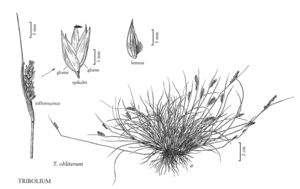| Taxon | Illustrator ⠉ | |
|---|---|---|
 | Tribolium obliterum | Hana Pazdírková Linda A. Vorobik |
Plants annual or perennial; cespitose, sometimes stoloniferous, occasionally with rhizomes. Culms 2-60 cm. Sheaths open, throats glabrous or long-ciliate; ligules of hairs, or membranous and ciliate, or ciliolate; blades flat or rolled, glabrous or villous. Inflorescences terminal, sometimes also axillary, panicles, spikes, or racemes. Spikelets with 2-5 (10) florets, distal florets reduced; disarticulation above the glumes and between the florets. Glumes exceeding or exceeded by the florets, herbaceous, 3-5-veined, glabrous or scabridulous, sometimes with stiff, papillose-based hairs, glume apices acute or acuminate; calluses glabrous; lemmas herbaceous, with acute or clavate hairs in marginal rows or variously scattered, lemma apices unlobed, acute to long-acuminate; paleas sometimes with tufts of hairs on the margins; lodicules 2, obtriangular, glabrous or with bristles, 1-3-veined, lodicule apices at least as thick as the base; anthers 3, 0.3-3.1 mm. Caryopses 0.7-2.2 mm long, 0.4-1.1 mm wide; pericarp poorly separable, dull, smooth or rugulose, glabrous; embryos 1/3 – 1/2 as long as the caryopses; hila punctiform. x = 6.
Discussion
Tribolium is a southern African genus of 10 species. It is unusual in the tribe in having unlobed lemmas, but has the haustorial synergids, bilobed or bi-awned prophylls, and stalked ovaries characteristic of the tribe. Linder and Davidse (1997) suggested that its closest relatives are probably Schismus, Karroochloa, and Rytidosperma.
Selected References
Lower Taxa
"decumbent" is not a number.